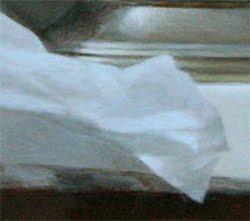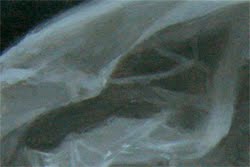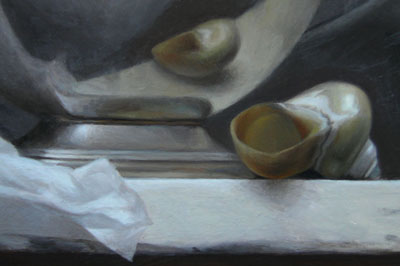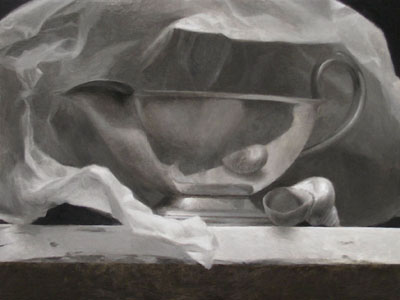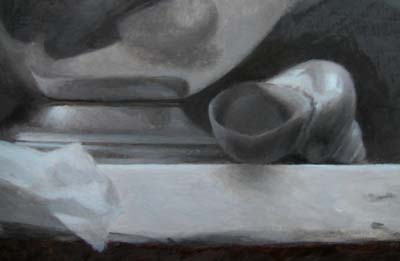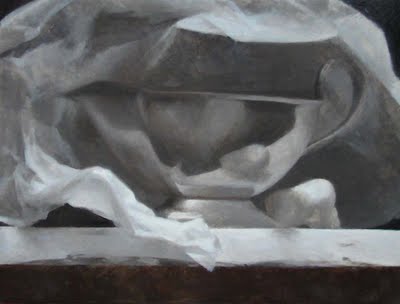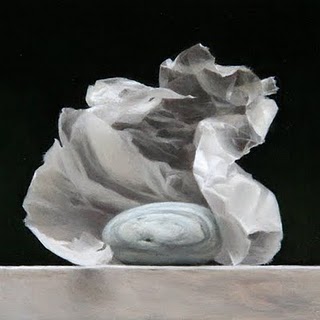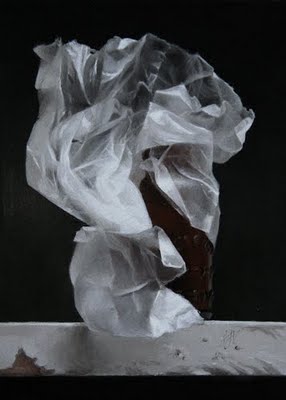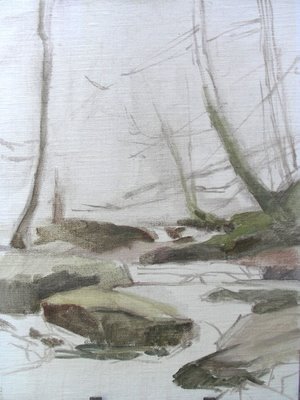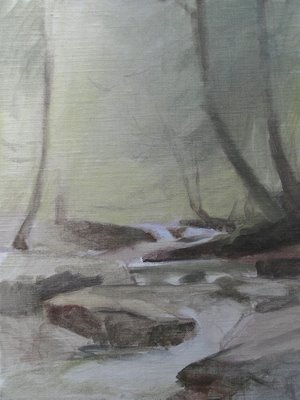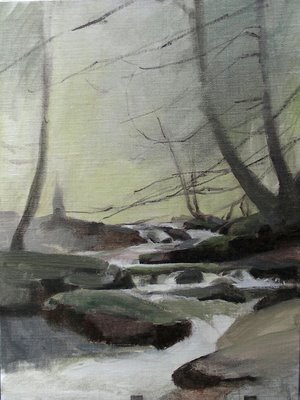I was just reading the comments in James Gourney's nice writeup for the Fellowship and realized I learned a lot about materials for outdoor painting during the trip and I thought I'd share.
Outdoor easel setup
Just about everyone was using a paint box palette mounted to a photographer's tripod for their plein air setup. (Some people preferred a light metal easel to mount their canvas and then held their palette in their hand, but there's so much to do with the non-painting hand outdoors - like swat mosquitoes - that I prefer a mounted palette).
Guerrilla Pochade Box
I started out with my 9"x12" Guerrilla box which has served me well on previous neighborhood plein air sketching but I quickly found it is too heavy and boxy for anything beyond a 10-minute hike. Considering I was climbing steep slippery rock steps most days to my waterfall site, I was really wishing for a lighter option. The plus side of the Guerrilla box is that it is extremely functional and sturdy and has tons of room for storing things. And its very cute boxy proportions draw lots of compliments. Emily Lee had the even cuter 6"x8" version and she was really happy with it, but you can see she sometimes had to use a handheld palette because the paint-mixing area is tiny.
Alla Prima Pochade
Everyone oohed and aahed over this nifty, well-designed box when it was shipped to Fellow Dorain Iten. The components are held together with magnets and the nice wood and beautiful design is eyecatching. He really liked using it, especially for the magnet that holds your palette knife while you work. The full version has awesome drawers and there is a "light" option that has separate storage compartments that attach with magnets, but even the light option still seemed a bit heavy for me.
Open Box M
Our instructors all used the "M" and after deliberating quite a while this is the option I decided to upgrade to. It's very expensive, but they offer a less expensive "kit" that includes a shoulder bag instead of the outer wooden box. However, I've personally found it very annoying to hike with a shoulder bag flopping over my arm. A backpack is the way to go.
After spending quite a bit of time on the site I finally figured out you can buy the palette/panel holder separately from everything else. I decided to order that alone, at 9"x10" and $195, and if I really feel the need I'll buy the wet panel carrier box separately later. Those two options even separately are less expensive than the kit that includes the shoulder bag - and much less expensive than the whole set which includes a wooden outer box. In the meantime, I'll use these lightweight "cocoon" wet panel carriers.
UPDATE: Lines and Colors posted a complete and detailed review of all the pochade box options available, be sure to check it out before you invest in one! It seems that Charley Parker went with the Alla Prima Pochade, it certainly looks like an amazing box. I'll come back and post and update later about how I like working with the Open Box M.
UPDATE 2: HRF Fellow Peter Sakievich posted a photo and description of his Open Box M setup on his blog.
Julian UmbrellaWe all were jealous of
Nick Hiltner's huge white umbrella that shielded him from rain, sun, and even more importantly... curious passersby! Several of us ended up ordering them and having them delivered directly to our location in the Catskills. Nick warned us that every part of the umbrella breaks often, but there really are no other options for white artist umbrellas we could find, and he said the manufacturer is willing to replace broken parts. Sure thing, the clamp contact has popped off, the umbrella has detached from the clamp (both luckily fixable on the spot) and after a week 3 spines had detached from the nylon. I reinforced every spine connection with duct tape so mine is not so pretty any more. All that said, it is a fantastic umbrella - it kept me dry even during one epic 3.5 hour downpour painting session. The white material casts perfect, diffused lighting on my canvas under all light conditions. And the most important feature... only the most brave passersby dare peek under the huge umbrella.
Camp Chair
I started out with the tiniest, lightest, overpriced at $20, 3-legged camp stool from REI, and in about 30 minutes realized it is miserable to sit on and has a bad habit of tipping. I "upgraded" to a folding, armless camp chair for $13 at the local hardware store. But I and everyone else who bought that one found that the seat and/or back canvas tore from the supports after a couple weeks of all-day painting sessions. The most hardcore of our group were lugging around full camp chairs with armrests which seemed like overkill to me, till I saw how nicely their umbrellas clamped to the arms, and how their turp jars nestled in the mesh cup-holders! So I might be upgrading to a fancy camp chair.
Painting Panels
I have been using wooden Art Boards in my studio and Gessoboard panels outside for a couple years now, but recently I'm finding I prefer a fine grade oil primed linen surface for outdoor painting (indoors I'll still use smooth wood for the most detail). I tried these:
Art Board oil primed linen 9"x12": $17.89
I liked the silky fine surface of these panels, but I found the damp conditions I was painting in made the panels warp forwards slightly. They will be fine once framed, but the warping was annoying on a multi-day painting.
Utrecht Master's oil primed linen 9"x12": $9.99
This panel is ok quality for a cheap price, and it's probably perfect for single-session plein air artists who like texture and thick paint. However, for multi-session painting with thin paint and more detail, this canvas has way too much texture.
New Traditions oil primed linen with gaterfoam 9"x 12": $10.17
Our instructors were using New Traditions and although I have not used them yet (just ordered my first batch) I was sold on their texture, lightweight archival gaterfoam core, and non-warping properties. And the price is right! You can choose different support materials and different finishes, but the portrait grade lead oil primed linen was my choice.
Tripod
I borrowed Dorians' tripod briefly but I loved it and hope to buy my own. The grip to move the ball head in any direction was easy and smooth and the tripod was really sturdy and even a tiny bit lighter than mine. It's the
Manfrotto 190XPROB and
Horizontal Grip Action Ball Head. It's expensive though, I might be waiting quite a while before I upgrade to this. There are much cheaper and lightweight tripods, and as with all things plein air the choice is between something durable/heavyweight versus something lightweight/flimsy.
 Sunday, November 29, 2009 at 9:12PM
Sunday, November 29, 2009 at 9:12PM 
